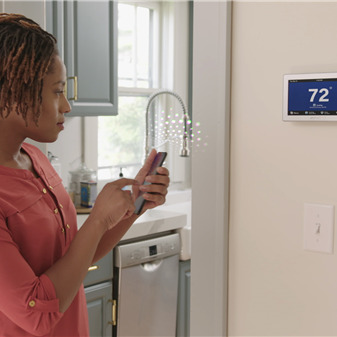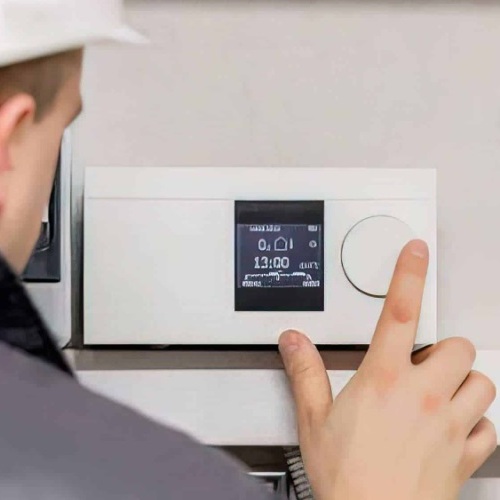
Elevate Your Home Comfort: A Comprehensive Guide to Upgrading Your Thermostat
In the rapidly advancing world of smart home technology, one often overlooked but highly impactful upgrade is the thermostat. While traditional thermostats serve a basic function, upgrading to a modern, smart thermostat can revolutionize the way you control your home’s climate, enhance energy efficiency, and bring convenience to your fingertips. In this comprehensive guide, we’ll explore the benefits, features, and considerations of upgrading your thermostat.
Transform your home comfort and energy efficiency with a simple upgrade – invest in a smart thermostat today! Enjoy the convenience of remote control, personalized schedules, and significant energy savings. Don’t let outdated technology hold you back; make the smart choice now. Upgrade your thermostat and experience a more comfortable, efficient home! Give us a call today at (254) 501-7318.
The Basics of Thermostats:
Before diving into the world of smart thermostats, it’s essential to understand the role of a thermostat in your home’s heating, ventilation, and air conditioning (HVAC) system. Traditional thermostats regulate indoor temperature by turning the HVAC system on or off based on the set temperature. While this method is functional, modern thermostats offer a range of features that go far beyond simple temperature control.
Benefits of Upgrading Your Thermostat:
- Energy Efficiency:
- Smart thermostats are designed to optimize energy usage by learning your habits and preferences. They can create a heating and cooling schedule that aligns with your daily routine, ensuring your HVAC system runs only when necessary. This results in lower energy bills and a reduced environmental impact.
- Remote Access:
- One of the most significant advantages of smart thermostats is the ability to control your home’s temperature remotely. Whether you’re at work, on vacation, or just lounging on the couch, you can adjust settings using a smartphone app. This remote access provides unparalleled convenience and allows you to maintain comfort while saving energy.
- Learning Capabilities:
- Many smart thermostats come equipped with learning algorithms that adapt to your habits over time. They analyze your temperature preferences, occupancy patterns, and even weather conditions to create a personalized schedule. This learning capability ensures optimal comfort without the need for constant manual adjustments.
- Integration with Smart Home Ecosystems:
- Smart thermostats seamlessly integrate with popular smart home ecosystems like Amazon Alexa, Google Assistant, and Apple HomeKit. This compatibility allows you to control your thermostat using voice commands and facilitates coordination with other smart devices in your home.
- Energy Usage Reports:
- Stay informed about your energy consumption with detailed reports provided by smart thermostats. These reports offer insights into your heating and cooling patterns, helping you identify opportunities for further energy savings.
- Geofencing Technology:
- Some advanced smart thermostats use geofencing technology to detect when you’re approaching or leaving home. By adjusting the temperature based on your proximity, these thermostats ensure your home is at an optimal temperature when you arrive while conserving energy when you’re away.
- Smart Sensors and Zoning:
- Smart thermostats often come with additional sensors that can be placed in different rooms. These sensors help create zones within your home, allowing for more precise temperature control. This feature is particularly useful in larger homes where certain areas may require different heating or cooling levels.
Choosing the Right Smart Thermostat:
With myriad options, selecting the right smart thermostat for your home can be overwhelming. Consider the following factors to make an informed decision:
- Compatibility:
- Ensure the smart thermostat is compatible with your existing HVAC system. Most smart thermostats work with conventional heating and cooling systems, but some may require specific wiring or components.
- Ease of Installation:
- Look for thermostats with straightforward installation processes. Some models are designed for easy DIY installation, while others may require professional assistance.
- Smart Home Integration:
- If you already use smart home devices, choose a thermostat that seamlessly integrates with your existing ecosystem. This ensures a cohesive and interconnected smart home experience.
- Learning Capabilities:
- Consider a thermostat with learning capabilities that adapts to your habits over time. This feature enhances convenience and energy efficiency.
- Remote Access and App Functionality:
- Ensure that the thermostat offers a user-friendly mobile app for remote control. The app should provide real-time data, energy reports, and easy customization of temperature schedules.
- Energy Efficiency Ratings:
- Check for energy efficiency ratings and certifications. Look for devices certified by ENERGY STAR or other relevant organizations, as they meet stringent energy efficiency standards.
- Additional Features:
- Evaluate additional features such as geofencing, smart sensors, and compatibility with voice assistants. These features can further enhance the functionality and convenience of your smart thermostat.
Installation and Setup:
Once you’ve chosen the right smart thermostat for your home, the installation process is a crucial step. While many models are designed for DIY installation, it’s essential to follow the manufacturer’s guidelines to ensure proper setup. If you’re unsure or uncomfortable with the installation process, consider hiring a professional HVAC technician to guarantee a seamless transition.
Setting Up Your Smart Thermostat:
- Connect to Wi-Fi:
- Most smart thermostats require a Wi-Fi connection for remote access and app functionality. Follow the manufacturer’s instructions to connect your thermostat to your home’s Wi-Fi network.
- Download the App:
- Download the corresponding mobile app for your smart thermostat from the App Store or Google Play. Create an account and follow the app’s instructions to link it to your thermostat.
- Register Your Device:
- Register your smart thermostat with the manufacturer, if required. This step may provide access to software updates, extended warranties, and customer support.
- Configure Preferences:
- Use the app to configure your temperature preferences, schedule, and any additional settings. Take advantage of learning features if your thermostat has them by providing initial input about your habits.
- Install Additional Sensors (if applicable):
- If your smart thermostat supports additional sensors for zoning, install them in relevant areas of your home. Follow the manufacturer’s guidelines for optimal placement.
- Test the System:
- After installation and setup, test the system to ensure it’s functioning correctly. Verify that the thermostat responds to manual adjustments and that remote access through the app is working as intended.
Getting the Most Out of Your Smart Thermostat:
Now that your smart thermostat is installed and configured, here are some tips to maximize its benefits:
- Regularly Update Software:
- Check for and install software updates provided by the thermostat manufacturer. These updates may include bug fixes, performance improvements, and new features.
- Optimize Temperature Settings:
- Fine-tune your temperature schedule based on changing seasons and occupancy patterns. Adjust settings to optimize comfort while maximizing energy savings.
- Utilize Vacation Mode:
- When you’re away from home for an extended period, activate the vacation mode on your thermostat. This setting ensures energy-efficient operation during your absence.
- Explore Integration with Other Devices:
- If your smart thermostat is compatible with other smart devices, explore ways to integrate them. For example, coordinate with smart lighting or window shades to further enhance energy efficiency.
- Review Energy Reports:
- Regularly check the energy reports provided by your smart thermostat. Use the insights to identify patterns, make adjustments, and track the impact on your energy bills.
- Take Advantage of Voice Commands:
- If your thermostat integrates with voice assistants like Alexa or Google Assistant, leverage
Transform Your Home
Ready to transform your home comfort and energy efficiency? Upgrade to a smart thermostat today! Experience remote control, energy savings, and personalized comfort at your fingertips. Don’t miss out on the future of climate control – take the first step to a smarter home. Call (254) 501-7318 to explore our range and make the switch now!


